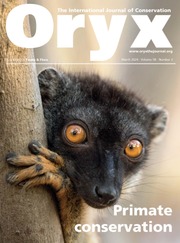Although the use of wildlife for ornaments is not new, the large-scale harvesting and fashioning of animals into curios is a growing phenomenon, exacerbated by e-commerce. Concern about the conservation threat posed by online ornamental trade to Southeast Asia's bats (including painted woolly bats Kerivoula picta), which are sold as taxidermied specimens and skeletal remains, was first raised by Lee et al. (2015, Oryx, 49, 204).
We (the IUCN Species Survival Commission Bat Specialist Group, Bat Trade Working Group) systematically quantified the online trade in these distinctive orange and black bats on the USA's three biggest shopping websites: Amazon, eBay and Etsy (Coleman et al., 2024, European Journal of Wildlife Research, 70, 75). Our results, gathered over just 3 months, suggest that in 2022 alone, hundreds of K. picta were imported into the USA.
We determined that this trade was probably illicit (by analysing relevant laws in source countries and the USA) and recommended enhanced legal protection for K. picta. Before our paper was published, we communicated our findings to the Center for Biological Diversity, which, in May 2024, together with the Monitor Conservation Research Society, submitted a petition to add K. picta to the U.S. Endangered Species Act. This listing should raise border scrutiny and reduce USA imports of ornamental bats. This petition was publicized on the websites of the Center for Biological Diversity and the non-profit Lubee Bat Conservancy, and on social media.
The frequent use of seemingly deceptive sales tactics (e.g. statements that bats had been sustainably sourced) in the listings we analysed suggests that buyers may not be aware of their inadvertent contributions to bat population declines. We suggested this issue be publicized, reasoning that heightened public awareness could reduce demand and that media exposure could push e-tailers to ban sales of bats. We acted on our recommendation via carefully coordinated efforts by Queens College, City University of New York and the University of California, Davis. Joint press releases by their press offices on 16 July 2024 elicited considerable media attention, including a front-page New York Times article (nytimes.com/2024/07/25/climate/taxidermy-bats-kerivoula-picta.html).
All these efforts, including those by countless people and organizations who circulated these articles and social media posts, had a major impact. By mid-August 2024, eBay and Etsy had removed all bat listings from their platforms worldwide and in the USA, respectively, with both companies implementing concrete policies prohibiting bat trade. This remarkably swift success story highlights how conservation researchers and practitioners working with the media to effectively communicate their message can galvanize diverse actors around a mission and achieve the ideals of corporate social responsibility. We gratefully acknowledge everyone involved and encourage other e-tailers to adopt similar policies. This outcome has strengthened our commitment to ending the unsustainable ornamental bat trade. We are now working to address supply chains (e.g. market surveys in Southeast Asia) and preparing to push for K. picta to be listed in the CITES appendices at the 2025 Conference of the Parties.


